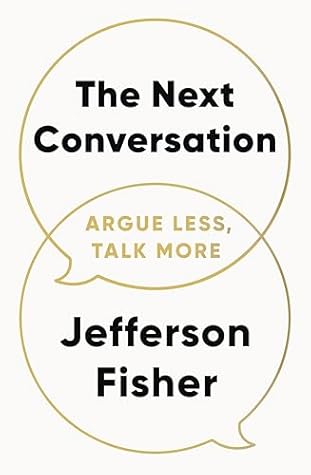More on this book
Community
Kindle Notes & Highlights
Read between
July 8 - August 7, 2025
Instead of passively expecting that the conversation will magically go in your favor, or that your friend will suddenly see the light, you spend time thinking about a proactive approach. You set a goal of gaining a better understanding of each other’s perspectives. You choose gratitude as your guiding value, a feeling of thankfulness for this friend and the memories you’ve shared. And now you’re ready for a redo. As the two of you sit down, you say, “Thank you for meeting with me.” “Yeah, of course. I wanted to,” your friend replies. You lead the conversation. “I could’ve done better.” Your
...more
To stay in control even in the most chaotic conversations, these are the three most effective tools I’ve developed: Your first word is your breath. Your first thought is a quick scan. Your first conversation is a small talk.
the best time to take a conversational breath is either while the other person is talking and you’re listening or shortly before you respond.
Box breathing,5 for example, in which you inhale, hold, exhale, and hold, each for a measure of four seconds, is a pattern of rhythmic breathing. It creates intentionality and regularity in the breath. The benefit of rhythmic breathing6 is a lower heart rate, which can sharpen a soldier’s mental focus.
Confidence is found in the doing. And that doing is called assertiveness. Confidence is as assertive does. Assertiveness is how you express confidence. Unlike confidence, which is a feeling, asserting is an action. You can think of it as confidence is an inside thing, while assertiveness is an outside thing. To assert yourself is confidence in motion. Assertiveness is found in the way you say things, the way you lean into your words.
Confidence and assertiveness feed into each other.
vocabulary of assertive words and commonly used phrases
sound and intonation patterns that embody self-respect.
emails, texts, and videoconferences, you’ll begin to spot the opportunities to stand your...
This highlight has been truncated due to consecutive passage length restrictions.
sort of
maybe
just
“I’m attaching the contract,” or even “I attached the contract,” sounds more forward, more active, and more assertive. You’re leaning into your confidence by telling them what you’re doing and then doing it.
There is a sense of empowerment you’ll receive when you claim your words and see them through to fulfillment, like telling yourself, “Hey, I’ve got this.” You’re proving to yourself that you believe in your own abilities—small, assertive actions that accumulate into experiences that build your confidence.
By telling people what you’re going to do and then doing it, you’re proving that you’re the kind of person who, when you say something, you mean it. Otherwise, you’re bound to get walked over.
Take back control with assertive language and lean in. Tell them what you’re going to do, then do it: Instead of abruptly leaving and slamming the door, say, “I’m going to leave the room”—and then do so. Instead of suddenly hanging up the phone, say, “I’m going to end the call”—and then do so.
Think of it like calling your shot in a game of pool. Acting in line with your aim demonstrates self-assurance. You’re conveying that you’re not afraid to state your intention. You believe in your ability to deliver. And when you follow through, you solidify that belief. This consistency is part of the positive feedback loop, in which you say what you’re going to do and you do it. And you’ll feel more confident the next go-around. Confidence is showing up and proving to yourself that you’ll be there when you say you will. When you honor your self-promises, meet your own expectations, and use
...more
Instead of over-apologizing, use words of gratitude, or nothing at all. Before: “Sorry I’m late.” After: “Thank you for your patience.”fn1 Before: “Sorry to bother you.” After: “I appreciate your help.”
Before: “Sorry for all the questions.” After: “Thank you for clarifying that for me.”
One of the biggest separators between those who show confidence and those who don’t is how often they feel the need to say something. It’s a dead giveaway.
“Then I won’t be repeating this,” my client said firmly. “I’m getting off this roller coaster. If you want to get off with me, do it now. And I’ve always loved you.”
When someone belittles, patronizes, or condescends to you, try these steps: 1. Make them say it again
“Did you mean for that to sound rude?” (or offensive or dismissive)
“Did you mean for that to come across short?” “What did you intend with that statement?”
“How did you expect me to react to that?” “Was that meant to be h...
This highlight has been truncated due to consecutive passage length restrictions.
there’s something you need to know. Not everyone will like it. Some will even hate it. But they’ll still respect you for it.
“I hear your point. I need to finish the conversation we started. And if needed, I’m willing to come back and address that comment.” “Stay with me. Hear me out, and if we need to come back to that we can.” “I agree that’s worth talking about too. Let’s focus on one issue at a time.”


